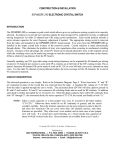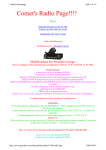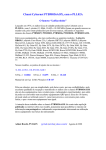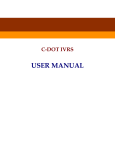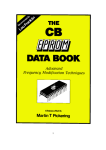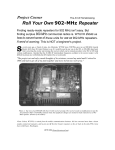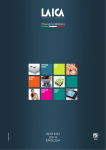Download Uniden AX 144 Specifications
Transcript
CONSTRUCTION, INSTALLATION, & OPERATION EXPANDER 160 CRYSTAL OSCILLATOR & SWITCH © The EXPANDER 160 is a compact crystal oscillator unit which allows remote controlled selection of up to four different crystals. This provides new injection signals for loop mixing in PLL synthesizer circuits, or additional synthesizer frequencies in 23-channel CB transceivers. The RF output is approximately 5 V peak-peak when supplied at +8 VDC, and is buffered to minimize loading at its connection. Each crystal position includes a series trimmer capacitor for exact frequency adjustment. Crystal selection is made by diodes, which eliminates the problem of stray wire capacitance often found in mechanical switches. A unique system of wire jumpers allows the EXPANDER 160 to be used solely as a crystal switch, with the oscillator circuit disconnected. This configuration is needed for all 23-channel crystal-synthesized radios, and all 40-channel PLL radios whose crystal frequency is doubled or tripled before mixing with the VCO signal. In such radios, the existing crystal is removed from the radio’s chassis, and two EXPANDER 160 wires are installed at the empty crystal location. The removed crystal is soldered into the EXPANDER 160 PC board, along with up to three new crystals. The module is now in series with the radio’s crystal circuit. This allows up to four crystals (the original plus your three) to be chosen instead of just the original. The radio’s total operating range and bandwidth will depend upon the specific chassis type. CIRCUIT DESCRIPTION See the Schematic Diagram on Page 9. The EXPANDER 160 consists of a Colpitts oscillator, bipolar buffer stage, a diode switching array, and various jumper wire options. One of four crystals is chosen when a DC voltage is applied through your hard switch (toggle, rotary, slide, CB/PA, etc.) to one of the PC board holes numbered “1” through “4.” The “5” hole is the common hot side for the hard switch, and connects directly to the radio’s regulated +DC supply bus. With voltage applied, the appropriate diode (D1-D4) is turned on by the current flowing through it and R1/L5 to ground. R1 limits the current to a safe value. L5 keeps all crystals above RF ground, since the crystal’s hot side is being switched. RF is decoupled from the DC power supply by L1-L4 and C1-C4. OSCILLATOR MODE The Colpitts oscillator common to CB radios has a relatively high shunt or parallel input capacitance. This can pull the crystal off frequency, so series trimmers CT1–CT4 are provided for exact adjustment after installation. The trimmers have a range of 9-50 pF, which is more than enough if proper crystals are specified when ordering. Jumpers J4-J7 are installed for the OSCILLATOR Mode, and are used to ground one side of the crystals. Sometimes a particular crystal can be difficult to trim to the correct frequency. In such cases, you can often replace the bare jumper wire with a small capacitor (5-68 pF) or RF choke (1-10 µH) to get the oscillator within the range of the trimmers. Q1 is the oscillator. R2, R3, and R4 provide the DC operating biases, and are chosen to oscillate with any crystal between 10-20 MHz at DC supply voltages of about +5-12 VDC. C6 is the feedback capacitor which causes oscillation. The values of C6 and C7 are chosen to oscillate with any fundamental crystal from approximately 8 MHz to 20 MHz, or any Third Overtone crystal type. (Typically these are in the 36 MHz range, and are actually cut near 12 MHz.) Q2 is a buffer stage which isolates the oscillator from possible loading effects in the radio. C8 has purposely been kept small (22 pF) for this same reason. DC operating power comes from the radio. The source must be well regulated for maximum frequency stability. Most CB transceivers all have at least one such source, usually +5-8 VDC, and this is used to power the EXPANDER 160. The DC source you choose must be present for both RX and TX. Connect the RED wire to that, and the BLACK wire to chassis common. SWITCH MODE The EXPANDER 160 is connected as a straight electronic switch in many PLL radios, and always in the older crystal-synthesized radios. In this mode J8 is left out, which disconnects the active transistor stage. J4, J5, J6, and J7 are also removed, and J1, J2, and J3 are used instead. This ties the low side of all crystals together at hole “A,” and all the high sides together at hole “B.” In most radios the crystals are not directly grounded, grounding instead through a Delta Tune or Clarifier VXO circuit on the crystal’s low side. Thus the jumpers allow the EXPANDER 160 to be used as a multiple series crystal switch. Wires from holes “A” and “B” are installed in the appropriate holes formerly occupied by the original mixing crystal. Crystals are chosen by diodes D1-D4, in exactly the same way as the OSCILLATOR Mode. © Copyright 1983–2002 by L.M. Franklin. All rights reserved. Published by: CBC INTERNATIONAL • P.O. BOX 30655 • TUCSON AZ 85751 U.S.A. TEL/FAX: 888-I-FIX-CBs (1-888-434-9227), (520) 298-7980 Internet: www.cbcintl.com • Email: [email protected] ASSEMBLY INSTRUCTIONS PLEASE READ CAREFULLY BEFORE PROCEEDING! NOTICE This device will operate as advertised when properly constructed, installed, and adjusted. CBC INTERNATIONAL has no control over the skill of the purchaser; therefore no warranty can be given. We will repair units built only from our own kits for $25 prepaid with the returned unit. NO BASKET CASES PLEASE! This device is intended for educational purposes, 10-Meter Amateur use, or 27 MHz receivers only. Supplier assumes no liability for improper or illegal use. Proper soldering is essential. Poor soldering is the biggest cause of problems. Finished joints should look shiny, never dull. Use only a small iron (25-45 watt) with a very fine round or slot tip to avoid shorts. Assembly consists of stuffing the parts into the proper PC board holes, as illustrated in the X-Ray View drawing, Page 10. Check against the schematic circuit diagram if you’re in doubt about the correct holes. Push all parts down tight, wiggling back and forth if necessary as you press down. (See photo, Page 11.) The diodes and resistors will bend naturally to the proper hole spacing. NOTES 1. Unless you’re moving the EXPANDER 160 unit from one type of synthesizer circuit to another, you will save time and trouble by installing the right jumper wires in the first place. Decide which installation type you need, then insert the proper jumpers when stuffing and soldering all the other parts. 2. Observe correct diode polarity. The banded diode end is the cathode [—]. This is shown in the sketch above and in the X-Ray View. Diodes also have [—] marks etched on the PCB. 3. Install transistors correctly. See sketch. Match the flat side of the transistor body with the flat side painted on the top of the PC board. The emitter leads will be to your left.. If in doubt, check against the X-Ray View or the schematic. With the flat side facing you, the leads will be (left to right) Emitter, Base, Collector. 4. Use cut off parts leads for the jumpers. Determine proper jumpers as described later. 5. Capacitor locations C6, C7, and C8 include extra holes to match different spacings if necessary. 6. Wires: Install the RED in [+], BLACK in [—], and short YELLOW in “RF” holes. An extra 12" wire is included for switch mode option, as well as the 5-conductor ribbon cable for your switch. Match cable to your switch and crystals with the schematic diagram. _________________________________________________________________________________________ EXPANDER 160 PAGE 2 CRYSTAL ORDERING The following specifications should be observed when ordering crystals. FREQUENCY: ACCURACY: HOLDER TYPE: CRYSTAL CUT: LOAD CAPACITANCE: As desired. .005% or better. HC18/U or HC49/U with solder leads. Fundamental up to about 20 MHz. Crystals which are being multiplied in the radio should be specified as such. (For example, the 11.325 MHz crystal used in the Cobra 148/2000GTL chassis is a tripler cut type.) 10 pF (series) preferred for easy adjustment. The 32 pF used in many CB oscillators can be hard to net by the trimmer alone. If you already have crystals with different specs, they can be tried first and will usually work. If you have the plug-in HC25/U types, these can also be used by drilling out the PC board holes to fit their thicker pins. The PC foil pads have purposely been made extra large for this reason. The drill size would be 0.052." Solder the pins directly to the PCB; using a crystal socket adds extra shunt capacitance. HOW TO FIGURE YOUR NEW CRYSTAL FREQUENCIES The effect of the EXPANDER 160 in a PLL circuit is always the same: the new injection signals simply drive the VCO up or down as required, until the input to the PLL’s Programmable Divider is correct and the loop locks. (This assumes the radio has not been modified by binary code changes, or has otherwise been returned to its stock circuit configuration before installation.) Figuring new crystal frequencies is therefore a matter of adding or subtracting the desired amount of up or down shift, respectively, to the output side of the PLL’s Mixer stage. The 40-channel CB band has a total bandspread of 440 KHz (27.405 MHz - 26.965 MHz = 440 KHz); the older 23-channel PLL radios have a bandspread of 290 KHz (27.255 MHz - 26.965 MHz = 290 KHz.) For continuous expanded range, each new crystal must add or subtract 450 KHz or 300 KHz respectively, to the preceding crystal. When the oscillator signal is used directly without multiplication, add or subtract the 450/300 KHz directly to each succeeding crystal. If the crystal is one that’s being doubled or tripled, add 1/2 or 1/3 of the 450/300 KHz respectively, to each succeeding crystal. The same principle applies to 10-Meter Amateur conversions. If you want the Channel 1 operating frequency to start, say, exactly 2 MHz higher (28.965 MHz), just add 2 MHz to a direct loop crystal, 1/3 of 2 MHz (667 KHz) to a tripler crystal, or 1/2 of 2 MHz (1 MHz) to a doubler crystal. Refer to the later examples, which should clarify this idea. CRYSTAL SUPPLIERS CRYSTEK CORP. 2351/2371 Crystal Dr. Ft. Myers FL 33907 TEL: (800) 237-3061, (941) 936-2109 FAX: (941) 939-4226 www.crystek.com INTERNATIONAL CRYSTAL MFG. 10 N. Lee Av., P.O. Box 26330 Oklahoma City OK 73102 TEL: (800) 426-9825, (405) 236-3741 FAX: (405) 235-1904 www.icmfg.com JAN CRYSTALS 2341 Crystal Dr. Ft. Myers FL 33907 TEL: (800) 526-9825, (941) 936-2397 FAX: (941) 936-3750 PARTS SUPPLIERS CIRCUIT SPECIALISTS INC. 220 S. Country Club Dr. #2 Mesa AZ 85210 TEL: (800) 528-1417, (480) 464-2485 FAX: (480) 464-5824 www.web-tronics.com DIGIKEY CORP. 701 Brooks Av. South P.O. Box 677 Thief River Falls MN 56701. TEL: (800) 344-4539, (218) 681-6674 FAX: (218) 681-3380 www.digikey.com MOUSER ELECTRONICS 1000 N. Main St. Mansfield TX 76063 TEL: (800) 346-6873, (817) 804-3888 www.mouser.com _________________________________________________________________________________________ EXPANDER 160 PAGE 3 INSTALLATION NOTE: The radio’s tuned circuits may need realignment after installation of the EXPANDER 160. Much depends upon the desired center operating frequency of the expanded radio. Therefore a schematic diagram of the radio is essential, as well as an accurate Frequency Counter. Although specific installation points are described for some popular models, the work should be done by a qualified electronic technician. The supplier assumes no liability for damage to any equipment resulting from improper installation. GENERAL INSTALLATION BY CHASSIS TYPE Radios to be expanded can be classified into four general categories. TYPE 1: All 23-channel AM or AM/SSB having crystal synthesizers. TYPE 2: All AM or AM/SSB PLL types having a crystal oscillator loop mixing stage which is doubled or tripled by subsequent tuned circuits. TYPE 3: All AM or AM/SSB PLL types having a fixed crystal oscillator loop mixing stage operating directly at the crystal frequency. TYPE 4: All AM or AM/SSB PLL types with a loop mixing signal generated indirectly from some other crystal-based circuit. Instead it comes from another area of the PLL circuit. An example would be the very common 15.36 MHz mixer signal generated from a tripled 5.12 MHz PLL IC pin. For the TYPE 1 and TYPE 2 radios, the EXPANDER 160 will be used only in its SWITCH mode. For the TYPE 3 and TYPE 4 radios, the OSCILLATOR mode will be used. Each mode is determined by specific jumper wires on the PC board; install the correct jumper wires for the desired mode. Remember that any 40-channel radio modified by crystal mixing will still have exactly the same channel skips as the standard 40 channels. Examples include the five in-between “A” channels, and the non-continuous frequencies between Ch. 22 and Ch. 26. These skips are physically built into the sealed binary or BCD Channel Selector switch, and can’t be changed. Page 5 shows the general connection points for each type. Remember, you must check the radio’s schematic for the exact location. IMPORTANT: Regardless of the installation type, the YELLOW “RF” output wire (or “A” and “B” hole wires if used) must be as short as possible. The YELLOW kit wires have purposely been left at 6" lengths for this reason. Find a mounting location where these wires can be connected into the radio’s PC board without needing any longer lengths. Stray capacitance from long wires can detune the circuit, or even keep the crystals from oscillating. The switch wires can be any length, and a 1-foot ribbon cable is provided for this purpose. TYPE 1 INSTALLATION — All 23-Channel AM or AM/SSB Crystal-Synthesized Radios See Figure 1. These radios all use banks of crystals that mix together, most often in the 6-4-4 or 6-4-2 configurations. For SSB types there are a few extra crystals in the Carrier Oscillator and synthesizer stages to provide the SSB frequency offsets; these have no effect on the location of the EXPANDER 160. The crystals to be added will go in the bank containing the six mixing crystals, regardless of whether the radio is AM or AM/SSB. These six crystals always mix to control the following six continuous channel groups: Channels 1, 2, 3, 4 Channels 5, 6, 7, 8 Channels 9, 10, 11, 12 Channels 13, 14, 15, 16 Channels 17, 18, 19, 20 Channels 21, 22, 23 For example, the most common AM schemes use a 37 MHz master oscillator plus separate 10 MHz oscillators for RX and TX (Figure 1A), or banks of 23 MHz, 14 MHz, and 11 MHz RX and TX oscillators (Figure 1B). Most older SSB radios generally use crystals in the 7.8 MHz or 11 MHz range, in the 6-crystal mixing bank. Remove one of the six crystals from the radio and place it in the #1 crystal position of the EXPANDER 160 instead. To make it easy remembering which Channel Selector positions provide which new channels, you should remove either the lowest or the highest frequency mixing crystal, depending upon whether you are expanding the radio below Ch. 1 or above Ch. 23. Install your new crystals in the remaining three positions of the EXPANDER 160. Put them in the correct position order (#2, #3, #4) so that your chosen switch makes the frequency bands continuous. Since you’re adding an extra three crystals, and each one will be mixed in the radio with four others, this means you will get a total of twelve additional new channels. Cut a 12" piece of hookup wire (provided in our kits) in half. Place the two pieces in the “A” and “B” holes of the EXPANDER 160. Install wire jumpers to put the EXPANDER 160 in the SWITCH mode; i.e., remove J8, J4, J5, J6 and J7 and install jumpers in the J1, J2, and J3 positions as shown on the X-Ray View and the PC board legend. Install the two loose wire ends from holes “A” and “B” in the two empty holes where you removed the mixing crystal, being sure to put the “A” wire in the low or ground side hole, and the “B” wire in the hot or oscillator side hole of the radio. EXAMPLE A: Cobra 29 AM chassis. This uses the standard 23 MHz and 14 MHz mixers, with the 11.730 MHz RX and 11.275 MHz TX oscillators. There are six 23 MHz crystals, and these are the ones to change. (Figure 1B.) Note that they change in 50 KHz steps: 23.290, 23.340, 23.390. 23.440, 23.490, 23.540. The next three for continuous lower frequencies would be 23.240, 23.190, and 23.140 KHz.. This gives twelve continuous lower channels from 26.955 MHz downward in the Ch. 1-4 positions, four channels for each of the three new crystals plus the original 23.290 MHz. _________________________________________________________________________________________ EXPANDER 160 PAGE 4 EXAMPLE B: Cobra 134/138/139/Midland 13-895 AM/SSB chassis. This uses 8 MHz and 11 MHz mixing banks, with a 7.8 MHz Carrier Oscillator. The 8 MHz are the ones to change, since there are six of them. Once again, they change in 50 KHz steps: 8.1590, 8.2090, 8.2590, 8.3090, 8.3590, and 8.4090 MHz. The next three for continuous higher frequencies would be 8.4590, 8.5090, and 8.5590 MHz. This gives you the next twelve channels (Ch.26-37) from 27.265 MHz to 27.375 MHz in the Ch. 1-4 positions, four channels for each of the three new crystals plus the original 8.4090 MHz. For 10-Meter use, add the desired Ch.1 up-shift to the highest radio crystal, 8.4090 MHz. You’d then install up to ten new 8 MHz crystals, six in the radio, and four more in the EXPANDER 160. NOTE: These old CBs will never cover both the 10M and 11M bands without retuning. You could get a straight 23 channels on 10M by just replacing the existing six crystals, without using the EXPANDER 160. Using it, you’d get 23 channels plus 12 channels more, for a total of 35 channels on 10M. This assumes you’re willing to buy a total of ten new crystals, six to replace the radio’s originals, plus four to fit in the EXPANDER 160. Obviously, you could choose anything from 12 channels on up to 35, depending upon how much you’re willing to spend on new crystals. TYPE 2 INSTALLATION — All PLL AM or AM/SSB with Doubler or Tripler Oscillators Refer again to the sketch above. In these radios, the crystal oscillator is doubled or tripled in frequency to get close to the output frequency of the VCO, which is typically operating in the 33-38 MHz range. The multiplier stage can not be bypassed for two reasons: 1. The SSB versions will have USB/LSB offset tuning adjustments following the multiplier stage. 2. There is usually a Delta-Tune (AM-only rigs) or Clarifier (AM/SSB rigs) circuit on the low side of the crystal, which must be retained for proper operation. The EXPANDER 160 must be used in its SWITCH Mode for these types. Jumper for this configuration as previously described. Remove the radio’s loop mixing crystal, and install it in the EXPANDER 160 along with your new crystals. Remember to use the correct crystal positions that match your desired switching order. Install two short hookup wires in the EXPANDER 160’s “A” and “B” holes. Place the other wire ends in the corresponding high side (“B”) and low side (“A”) holes where you removed the radio’s crystal. The net effect is that you now have several loop mixing crystals in series between the _________________________________________________________________________________________ EXPANDER 160 PAGE 5 Delta Tune or Clarifier (low crystal side) and the oscillator (high crystal side) circuit points. stage shown.) Bypassing that would kill the Clarifier! Check the radio’s schematic to determine the right mode to use. For the SSB radios in particular, it’s very important to adjust all crystals for the proper frequency. Make all adjustments in the “AM” mode. There should be enough range with the trimmers for exact netting, You should then check the USB/LSB offsets. These are usually ±1.5 to 2.5 KHz, as measured at the output of the tuned circuit which does the multiplication. Adjust the offsets according to the radio service manual, using the standard FCC band, Clarifier at its midrange. When switching to the new crystals, the existing offset adjustments should shift them by about the same amount. The Cybernet PLL02A SSB chassis uses trimmer capacitors for the offsets, while the Uniden SSB chassis types use coils to trim the offsets. EXAMPLE A: Any AM Courier model with the REC86345 PLL chip. The mixer crystal is 36.380 MHz. Use the OSCILLATOR Mode. New crystals might be 35.930 MHz for the lower 40, and 36.830 MHz for the upper 40 channels. These are tripler cut (Third Overtone) type crystals. EXAMPLE A: Cobra 140/142GTL Uniden chassis. This uses an 11.1125 MHz tripler crystal. New crystals might be 10.9625 for the lower 40, 11.2625 for the high 40, and 11.4125 MHz for the highhigh 40 channels. For 10 Meters, use 11.5575 MHz (28.300 to 28.740 MHz) or 11.4575 MHz (28.000 to 28.440 MHz) depending upon your need for the USB or CW/USB parts of the band. EXAMPLE B: Cobra 148/2000GTL, Uniden GRANT/MADISON chassis. The existing crystal is a tripler, 11.325 MHz. New crystals would be 11.175 for the lower 40, 11.475 for the high 40, and 11.625 MHz for the high-high 40 channels. For 10M, use 11.770 or 11.670 for USB or CW/USB respectively; coverage as shown above. NOTE: The 11.325 MHz crystal used in some older Cobra chassis is the oversize HC/33 type, not the standard HC/18 case. For CB expansion you’ll also have to replace that one, since the HC/33 won’t fit in the EXPANDER 160 PC board. EXAMPLE C: Cybernet PLL02A SSB chassis (Telsat SSB140, J.C. Penney 6247, etc.) The existing crystal is 10.0525 MHz and is doubled. New crystals would be 9.94 MHz for the low 40, 10.165 MHz for the high 40, and 10.2775 MHz for the high-high 40. For 10M, use 10.38625 for USB or 10.31125 MHz for CW/USB. EXAMPLE D: Early generation Cybernet PLL02A AM chassis with the 11.8066 MHz crystal. (Midland 13-857B, 13-882C, G.E. 35810B, Kraco KCB2320B, etc.) This crystal is being tripled. New crystals could be 11.6567 MHz for the low 40, and 11.9567 MHz for the high 40 channels. TYPE 3 INSTALLATION — All AM or AM/SSB PLL Radios with Direct Frequency Mixing See the previous page. The oscillator output is coupled through a small disc capacitor or tuning coil to the Mixer stage. You often have a choice of using the EXPANDER 160 in its SWITCH mode at point “A” like previous examples, or in its OSCILLATOR mode at point “B.” We suggest the OSCILLATOR mode. Remove this coupling capacitor, and place the YELLOW “RF” wire of the EXPANDER 160 in the empty capacitor hole (“B”) that goes to the Mixer side of the circuit. Remove the original radio crystal, and solder it into the EXPANDER 160 with the new mixing crystals. NOTE: In some AM/SSB chassis the SWITCH mode must be used, because the Clarifier circuit is part of the crystal’s low side. (Same as the Type 2 sketch, minus the doubler or tripler NOTE: Many other AM-only PLL radios also use the 36 MHz circuit. These include those with the SM5104, TC5080, µPD858, and µPD861 chips, as well as all the Royce “sardine can” type modular AM models. The same method works in all these too. EXAMPLE B: Cobra 29/89XLR Uniden chassis with µPD858 PLL chip. Either the SWITCH or OSCILLATOR modes could be used here. However the SWITCH mode is easiest because there is no coupling capacitor to remove; there is only a PC trace between the oscillator’s peaking coil secondary and the input to the TR18 FET Mixer. Rather than having to cut this trace, simply switch in new crystals along with the existing 36.57 MHz crystal. New crystals would be 36.12 MHz for the lower 40, and 37.02 MHz for the upper 40. These are also Third Overtone cuts. EXAMPLE C: Realistic TRC459/TRC480. Because the LC7113 PLL chip is now extinct and this chassis was very expensive, it’s worth saving and expanding! The loop crystal is 17.8875 MHz. Use the SWITCH Mode again, because the Clarifier is on the low side of this crystal. New crystals might be 17.4375 MHz for the lower 40, and 18.3375 MHz for the upper 40 channels. For 10 Meters, use 18.4825 MHz (CW/USB) or 18.7825 MHz (USB only). TYPE 4 INSTALLATION — All AM or AM/SSB PLL Radios with Indirect Frequency Mixing See Page 5 again. Almost all of these use a 15.36 MHz mixing signal which comes from the PLL chip itself. The chip has a 5.12 MHz output pin, and this signal goes through a tripler coil to produce 15.36 MHz which is then capacitively coupled to the Mixer along with the VCO signal in the 16-17 MHz range. Use the OSCILLATOR Mode. Remove the coupling capacitor and put the YELLOW “RF” wire of the EXPANDER 160 in the empty capacitor hole going to the Mixer side. NOTE: Because there’s no actual crystal to directly generate the 15.36 MHz signal, you must order this crystal along with the new ones so you can preserve the standard 40 FCC channels. Otherwise some complicated switching would be needed to connect this signal and disconnect the EXPANDER 160 when you want to change bands. For 10M Amateur conversions, this crystal would not be needed. EXAMPLE A: Cobra 29GTL/29LTD chassis with µPD2816 PLL chip. Use the OSCILLATOR Mode. Remove C87 (100 pF) in the PLL area. Typical new crystals are 14.91 MHz for the low 40, 15.36 MHz for the standard FCC 40, and 15.81 MHz for the high 40 channels. ____________________________________________________________________________________________ EXPANDER 160 PAGE 6 EXAMPLE B: All late generation Cybernet PLL02A AM chassis with 10.24 MHz and 10.695 MHz crystals. (HyGain 2702, Midland 77857, G.E. 3-5804D, etc.) In this circuit, the 10.24 MHz crystal is used not only for the PLL Reference Oscillator, but it is also doubled to 20.48 MHz and used for loop mixing. Use the OSCILLATOR Mode. Remove C17 (47 pF) from the chassis and install the YELLOW “RF” wire in the empty capacitor hole going to the IC2 Mixer. You will need a 20.48 MHz crystal to preserve the standard 40 FCC channels, as well as 20.03 MHz for the low 40 and 20.93 MHz for the upper 40 channels. EXAMPLE C: Early NDI Chassis with MC14526/MC14568 PLL circuit. (SBE Sidebander IV, Sidebander V, Console V.) Connect for the OSCILLATOR Mode. This chassis uses a 10.00 MHz crystal for the PLL Reference Oscillator, which is also doubled to 20.00 MHz for loop mixing. Remove C918 (1.5 pF). Install the YELLOW “RF” wire in the empty capacitor hole going to Mixer Q911. You’ll need a 20.00 MHz crystal to replace the removed signal. New crystals could be 19.55 MHz for the lower 40, and 20.45 MHz for the upper 40 channels. For 10M, use 20.595 MHz (CW/USB) or 20.895 MHz (USB only). NOTE: The later NDI chassis with the NDC40013 PLL chip works in exactly the same way. Those models include: Craig L131, L231, Johnson Messenger 4730, Johnson Viking 4740, NDI PC200, PC201, Pace 1000BC, 1000MC, SBE Console VI, Tram D64. EXAMPLE D: The Uniden µPD2824 SSB chassis. You must use the OSCILLATOR Mode. Currently includes the following models. PC833/PC965: Cobra 146GTL, Midland 6001(new), 7001 (new), Midland 79-260, Pearce-Simpson Super Cheetah (Australian), President AR-144, AX-144, P300, Realistic TRC451, Sears 663.3810, Uniden PC244. PB062: Realistic TRC453, Uniden PC122 PB105: Uniden Pro640e PB122: Realistic TRC465, Uniden Pro810e These popular models are still being sold. They require some extra modifications. The following special section is devoted just to them. Use the Chart below to find the specific part number being discussed in the text. Look under the columns “A” through “L” for the particular circuit function. Then substitute that part number as you’re reading the text. The small parts are located in the wax VCO mess IMPORTANT! The SSB Clarifier control will be lost unless you make the following changes. This chassis was purposely designed to use the 10.24 MHz PLL Reference Oscillator signal for the SSB offsets and the Clarifier too. (Precisely to discourage illegal Clarifier mods!) Special radio modifications are needed to make it work properly with the EXPANDER 160. The 5.12 MHz PLL tripler signal will be disconnected. Since you’re replacing it with an external 15.36 MHz oscillator (plus your choice of others), the SSB offsets and Clarifier wouldn’t work afterwards. The following steps will solve this problem, and will also give you much more slide range too. CRYSTALS TO USE: 14.460 MHz gives 26.065 to 26.505 MHz (LOW-LOW band) 14.910 MHz gives 26.515 to 26.955 MHz (LOW band) 15.360 MHz gives 26.965 to 27.405 MHz (FCC band) 15.810 MHz gives 27.415 to 27.855 MHz (HIGH band) 16.260 MHz gives 27.865 to 28.305 MHz (HIGH-HIGH +10M CW) 16.455 MHz gives 28.060 to 28.500 MHz (10M Novice band) You can pick a maximum of only 4 of the 6 possibilities! VCO BROADBAND 1. 2. Replace “A” (47 pF) with a .001 µF disc capacitor. This increases the control of the VCO varactor diode “F.” Replace both resistors “B” with 180Ω. This increases the gain of the VCO transistor stage “F.” CLARIFIER TX/RX SLIDER 1. 2. 3. 4. Remove parts “C.” This eliminates the fixed TX-only control. Replace “D” with a bare jumper wire; this adds an extra +0.7 VDC to the total varactor control voltage. Use your radio schematic to locate the Clarifier hot side. This is the end of the pot with the 8 VDC, RX-only normally on it. The newer chassis use ribbon cables, as the front panel is also a PC board. You’ll have to trace this conductor very carefully from the front panel to where it enters the main PC board. Lift that PCB wire, and put one end of your own wire in that hole. Run the other end of your wire over to “J.” This is the constant +8 VDC. The radio will now slide on both RX and TX. Check this out right now, before even installing the EXPANDER 160. In the next step the 10.24 MHz PLL stage will be modified; potential problems are much easier to isolate by logical testing of each step as you go. REQUIRED RADIO MODIFICATIONS 1. UNIDEN Chassis Type “A” “B” “C” “D” “E” “F” VCO Stage “G” 10.24 MHz Oscillator PC833 PC965 PB015 PB062 C75 (47 pF) R98 R99 D32 R122 D31 R102 R103 D25 R119 D24 TR23 D23 PB105 PB122 C72 (47 pF) R102 R103 D25 R119 D24 L14 TR20 D25 L13 TR21 D19 L13 Q21 D19 TR22 C72 (47 pF) C73 (5 pF) TR19 C66 (5 pF) TR20 C66 (5 pF) Q20 “H” Clarifier Varactor Diode D30 Q23 D23 Remove X1, the 10.240 (10.2417) MHz crystal. Solder one lead of a 4.7µF coil in the empty crystal hole that went to the [-] of “H.” Leave the other end standing up vertically for the moment. “I” 10.695 MHz Mode Offsets USB: L20/C102 LSB: L21/C103 AM: L19/C101 USB: L19/C97 LSB: L20/C98 AM: L18/C96 USB: L19/C97 LSB: L20/C98 AM: L18/C96 “J” Constant Regulated +8 VDC Collector of TR35 (2SA473) Pin 3, IC4 (HA17808) Pin 3, IC4 (HA17808) “K” 10.240 MHz Mode Offsets L16, L17, L18 (ignore all) OSC. = TR22 L17, L16, L15 (ignore all) OSC. = TR23 L17, L16, L15 (ignore all) OSC. = Q23 “L” TX Tuning Mixers & RF MIX: L40, L39, L38, L37 Final: L27 MIX: L37, L36, L35, L34 Final: L26 MIX: L37, L36, L35, L34 Final: L26 _________________________________________________________________________________________ EXPANDER 160 PAGE 7 2. Reinstall the crystal directly across the base of the oscillator “K” and ground. The simplest way is to first splice some short bare wires to its leads so it will reach the proper PC foil pads. Then lay it down flat on the solder side of the PC board and solder to the PC foil pads. Use electrical tape under it to prevent shorts. Alternately, you could also mount it vertically on the parts side of the PCB. This means drilling two very small holes in the PC board. You can use a #58 drill bit, or a #105 or #106 Dremel bit. Try to find a PCB spot where you only have to drill through the fiberglass. If you must drill through a foil, pick a wide one, like the common ground. Then scrape out an extra 1/8" around each hole to prevent shorts when you pass the spliced crystal leads through the drilled holes. Recheck for any possible shorts from the crystal leads to the PCB foils. EXPANDER 160 PREPARATIONS 1. 2. 3. Jumper for the SWITCH mode, even though you will actually use the OSCILLATOR mode. Remove jumpers J4, J5, J6, and J7 and install jumpers J1, J2, J3, and J8. Install a wire in hole “A.” Ignore hole “B.” Connect the loose end of the “A” hole wire to the top lead of the 4.7 µH RF choke you installed in Step 1 of the preceding section. Remove capacitor “E” (5 pF) from the radio. Connect the YELLOW “RF” wire to the empty hole going to the base of transistor “E.” Keep this wire very short; 3" should be plenty. This completes the installation. If you check the radio schematic and the sketch below, you’ll see that you’re now using the existing Clarifier circuit to slide the cold end of the EXPANDER 160’s crystal bank. The radio’s 10.240 MHz PLL oscillator is still functional. But now you’ve removed the “K” mode offsets and have added your own Clarifier tuning. The “I” offsets are the only frequency adjustments you’ll need besides each crystal trimmer in the EXPANDER 160. You can power the EXPANDER 160 from the same source as the Clarifier (point “J”). Ground the BLACK wire by soldering to the closest metal transformer can. Keep the YELLOW “RF” wire very short You can mount the unit along the PLL side of the radio frame using a small L-bracket. ADJUSTMENT & OPERATION, µPD2824 SSB MODELS A Frequency Counter or second SSB radio is required. Ignore any alignment instructions for the “K” coils, now out of the circuit. Set the Clarifier to the 12:00 knob position and adjust the AM “I” coils and crystal trimmers for the center channel on each band. (26.955, 27.405, 27.855 or whatever in the Ch.40 position.) By using a second SSB receiver with known accuracy and its own Clarifier at 12:00, you could then set the USB/LSB coils for the most natural voice sounds, without even needing a Frequency Counter. Use the best combination of adjustments you can find, consistent with good Clarifier range and knob symmetry. Adjust VCO coil “F” to cover the desired range. In most cases the maximum range is 160 channels before the VCO quits. Adjust all “L” RF coils for the most even RF power output across the desired range. RX sensitivity is usually OK as is, with no further adjustment needed. NOTES 1. Slide range varies from chassis to chassis and also depends upon crystal load capacitance. (Don’t exceed 20 pF when ordering.) You may get a case where there’s only about 2-3 KHz USB upslide with the Clarifier knob fully clockwise. To cure this, decrease the value of USB capacitor “I” by about 20-40 pF; this raises the USB frequency and makes the Clarifier tune in more closely to the center position. If you need still more range, try screwing the slug of the USB coil “I” all the way down to minimize its inductance. 2. You can sometimes boost the slide range by increasing your RF choke value from 4.7 µH to 10 µH maximum. Don’t exceed this amount! Before bolting the EXPANDER 160 to the radio frame, secure all adjustments and critical VCO parts. You can use an ordinary candle, dripping fresh wax around the VCO parts as well as the Clarifier varactor diode. In a pinch you can use your wife’s fingernail polish, but it’s harder to remove if you must retune. This circuit area is extremely sensitive, and must be mechanically secure from vibration or you’ll drift all over the band! Good DXing! NOTE: For chassis not included here, send a large #10 stamped self-addressed envelope and the exact radio make and model number. We’ll try to help. _________________________________________________________________________________________ EXPANDER 160 PAGE 8 _________________________________________________________________________________________ EXPANDER 160 PAGE 9 C1, C2, C3, C4, C9 = .01 mF R1, R5, R7 = lKΩ R2, R3 = 10KΩ R4 = 220Ω R6 = 2.2KΩ L1 - L5 = 470 mH CT1 - CT4 = 9-50 pF C5 = .001 mF C6 = 150 pF C7 = 68 pF C8 = 22 pF D1-D4 = lN914 Q1, Q2 = 2N3904 For OSCILLATOR mode, install jumpers J4, J5, J6, J7, J8. For SWITCH Mode, install Jl, J2, J3, and connect hookup wire to “A” and “B.” EXPANDER 160 PARTS LIST Most parts are available from Radio Shack except for the trimmers and RF chokes. See Page 3 for addresses of other suppliers. 5 each, .01 mF ceramic disc capacitor 1 each, .001 mF 1 each, 150 pF 1 each, 68 pF 1 each, 10 pF 3 each, 1KΩ 5% ¼-watt resistor (brown-black-red) 2 each, 10KΩ 5% ¼-watt resistor (brown-black-orange) 1 each, 220 Ω 5% ¼-watt resistor (red-red-brown) 1 each, 2.2KΩ 5% ¼-watt resistor (red-red-red) 2 each, 2N3904 transistor (2N2222A, ECG123A, Radio Shack #276-2009, 276-2016) 4 each, 1N914 fast-switching diode (1N4148, ECG519, SK3100, Radio Shack #276-1122) 5 each, 470 mH RF choke (Mouser/Circuit Specialists #43LS474) 4 each, 9-50 pF, 5mm micro-miniature trimmer capacitor (Mouser/Circuit Specialists #24AA024 or ME242-8050) 1 each, EXPANDER 160 Printed Circuit Board Misc: Crystals and switch per your requirements. (See text.) A complete kit is available for $38 postpaid from: CBC INTERNATIONAL, P.O. BOX 30655, TUCSON AZ 85751 USA _________________________________________________________________________________ EXPANDER 160 PAGE 10 _________________________________________________________________________________ EXPANDER 160 PAGE 11











